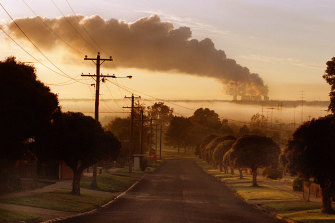Australia could easily beat its national emissions commitments without further action by the federal government after Victoria set a reduction target of 45-50 per cent by 2030.
The Yallourn power station is set to close in 2028, reducing Victorian emissions.Credit:Vince Caligiuri
Nationally, emissions would fall by 37 per cent of 2005 levels by 2030 if the states met their current goals, an analysis of state commitments by Anna Malos of the ClimateWorks policy advisory group housed at Monash University shows.
At present, the federal government has a target to reduce emissions by 26-28 per cent by 2030, though it is expected to increase this before the United Nations climate talks in Glasgow in November.
Ms Malos said the fact that the states’ targets would result in the nation beating its goals without any national action suggested there was far more the federal government – and the states – could be doing.
“In 2016 the Victorian government set a target of [reducing emissions by] 15 to 20 per cent by 2020. The numbers aren’t all in yet, but it looks like they will come in at 25 per cent,” she said.
Tim Baxter, a senior researcher with the Climate Council, welcomed the target as among the more ambitious of the state and territory goals, but noted it was based on calculating Victoria’s share of a global emissions budget for a 50/50 chance of temperatures exceeding 2 degrees.
“That’s not the same as aiming for ‘well below’ 2 degrees like the Paris Agreement demands,” he said.
“Climate leadership from states and territories has shown us what works, and the benefits that it brings. The federal government is being shown up for their near-total lack of ambition by the states, but to avoid the worst, everyone must up their game.”
ClimateWorks chief executive Anna Skarbek, who was a member of an expert panel that reviewed the Victorian target, said Victoria’s success in beating earlier targets was evidence that the Paris Agreement’s “ratchet” mechanism – by which jurisdictions are expected to set targets and then review and increase them – is working.
“What we know now is that it is easier to set targets, support them with policy and then increase them when there is already momentum,” she said.
Ms Skarbek said the target was in line with the goal of the Paris Agreement to keep warming to below 2 degrees above pre-industrial levels, but not 1.5 degrees.
Evidence suggests that Victoria would need to set a target range of 56-65 per cent reduction by 2030 and the nation a 74 per cent reduction to be on track for 1.5 degrees.
Ms Malos said the main drivers of emissions reductions in NSW, Victoria and South Australia had so far been renewable energy policies that were resulting in large-scale wind and solar power incorporated into the grid in addition to the adoption of rooftop solar panels. To maintain reductions, the states would need to increase the electrification of transport and industry.
This would be achieved more simply and quickly with federal government support, she said.
All Australian states and territories have set a goal of net-zero emissions by 2050. The federal government has not, saying it would “prefer” to hit this target sometime before 2050.
Start your day informed
Our Morning Edition newsletter is a curated guide to the most important and interesting stories, analysis and insights. Get it delivered to your inbox.
Most Viewed in Environment
From our partners
Source: Read Full Article



